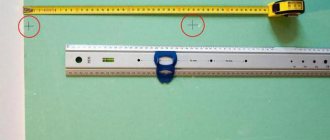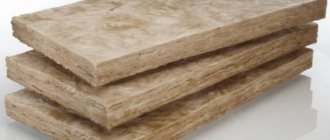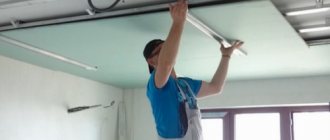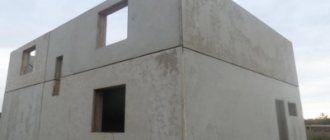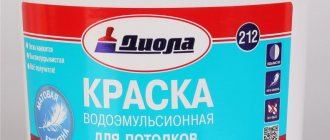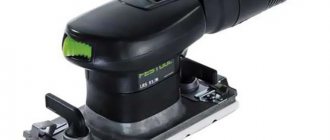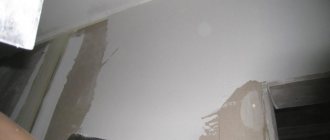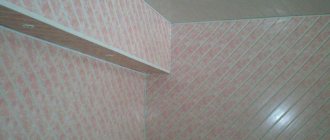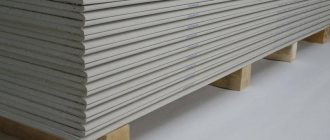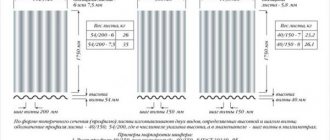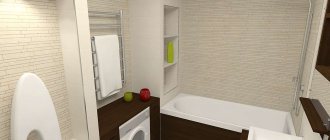GKL parameters, including the thickness of drywall for the wall, are regulated by GOST. There are two of them, both are operational: 6266 from Soviet times, 32614, developed by the Russian branch of Knauf (in accordance with the European EN standard), introduced in 2012.
Knauf gypsum boards As for structures with plasterboard and gypsum fiber sheets, they are subject to the same requirements set out in the code of rules (SP) 163.1325800.
Plasterboard thickness for walls
Page navigation
Drywall is a building material widely used for repair work. They use it to line walls, create partitions, arches, and ceilings of incredible beauty. It is suitable for creating shelves, niches, and interior products.
The thickness of the gypsum board for walls plays an important role. How to choose the correct dimensions of the material, what determine the selection parameters?
Types and technical characteristics
Modern industry produces several types of gypsum sheets. They all differ in their operational and technical characteristics. To choose the right drywall for a particular room, you should become more familiar with its properties.
Purpose
Gypsum fiber sheet
Gypsum fiber sheets (GVL) are a special group of gypsum finishing material. GVL slabs are made from a mixture of gypsum and cellulose fibers in a ratio of 5 to 1. The distinctive quality of gypsum fiber sheets, compared to gypsum plasterboard, is their increased strength. Thanks to this, fairly heavy suspended structures can be attached to the wall.
One self-tapping screw screwed into a gypsum plasterboard wall can withstand up to 30 kg of load.
GVL can be installed either on a pre-assembled frame or directly on a leveled load-bearing base. In the first case, the GVL is attached to the wall using self-tapping screws, and in the second - using construction adhesives. GVL adhesive can be either silicone sealant or “liquid nails”, and sheets can also be attached to brick and concrete surfaces using cement- or polymer-based tile adhesive.
Material advantages
Before purchasing GC sheets, you need to familiarize yourself with the pros and cons of the material:
- Thermal insulation. A leveled surface with material saves on heating costs. This is especially true if insulation is laid under the gypsum board.
- Flexibility. Drywall bends under a certain radius, this allows you to make decorative elements.
- Fire resistance. If a room catches fire, only the top layer that is not covered with a gypsum board finish will burn out - the gypsum does not burn.
- There are certain types of material used in the kitchen, bathroom, and balcony.
- When leveling the wall with material, communications, wiring and other cables are carried out behind the sheets.
With all the advantages of gypsum boards, there are disadvantages:
- fragility of the material. It breaks and crumbles, so installation work is carried out with caution;
- if you install the usual gray color in the kitchen or bathroom, it will absorb a lot of moisture and subsequently become deformed;
- before installing gypsum board on the surface, it is necessary to determine how thick it should be and whether the wall will be weighted;
The listed advantages show that the use of plasterboard is beneficial for leveling surfaces and creating other surfaces.
Classification of plasterboard by purpose
Premises intended for different operating conditions are subject to renovation: kitchens, bathrooms, living rooms and basements. And everywhere the finishing is susceptible to various influences: humidity, temperature, mechanical stress and others. To solve these problems, companies produce plasterboard panels that can withstand certain types of influence.
GKL
The most common types of sheets, most often referred to as wall sheets. They are used when decorating living rooms, as well as assembling partitions between them.
The material is installed on a frame or in a frameless manner. This allows you to create durable wall finishing in the shortest possible time.
Marked in gray on the planes.
But, for use in a humid microclimate, you need a different type - moisture resistant.
GKLV
Has green markings on the front side. The main purpose is to decorate walls and ceilings in rooms with a high level of water vapor in the air (moisture-resistant plasterboard sheets).
This is a good option for finishing the walls of bathrooms or semi-basement rooms; the filler contains an antiseptic additive that prevents the formation of fungus and mold.
In other respects, the slab does not differ from its wall counterpart, except for the price. Such panels are somewhat more expensive.
GKLO
The plasterboard sheet is fire-resistant - it is able to withstand and maintain an integral structure even when exposed to an open flame (for a limited period of time!). The effect is achieved by adding fire retardants to the composition.
The main specialization of the panels is the assembly and finishing of specialized structures: ventilation duct boxes, fireplace surrounds and others.
Marking on the front side in red or pink. Like other types of slabs, they are more expensive compared to wall analogues.
Other specialized types of plasterboard sheets are also produced.
- GKLVO is a moisture- and fire-resistant sheet that combines both properties.
- Acoustic plasterboard - provides sound insulation of rooms and proper acoustics.
- Arched - the purpose of creating curved configurations, a more plastic material.
- Laminated - has a PVC coating, not intended for living rooms.
What type of plasterboard do we recommend for indoor walls?
Which plasterboard is better to cover the walls in a room: characteristics
Before answering the question, it is necessary to list the external factors influencing the future design.
- Humidity in the room. If there is high humidity in the room: kitchen, bathroom, attic, corridor, use a moisture-resistant sheet - green plasterboard.
- Temperature conditions. With sudden changes in temperature, drywall can shrink and expand. This will lead to cracks. The leaf will burst.
- If the wall is located next to an active fireplace, it is necessary to install it with fireproof material. It resists high temperature and will not change the original appearance.
By using a regular HA sheet, the surface will deform in the shortest possible time. Having absorbed moisture, it will not come back out due to high humidity.
The purpose of the surface matters. If decorative finishing with gypsum board with figured elements is intended, then one sheet thickness of 12.5-9.5 mm is used. But, taking into account the hanging of shelves, a TV, a picture, a large mirror, a different material with a certain thickness of up to 24 mm is used. In some cases, the sheathing is installed in 2 layers.
What are the differences between other types of drywall?
Designer, arched or flexible material is used for shaped surfaces, for example, a suspended ceiling, bent with a small radius. It does not have to withstand heavy loads, but it bends well. This sheet does not need much thickness. Plus, its core contains several layers of reinforcing fabric, which ensures strength. Depending on the manufacturer, the sheet thickness is 6 or 6.5 mm.
Arched drywall
Reinforced or increased strength plasterboard is designed for heavy loads. Structures made from it can withstand the weight of a plasma panel or kitchen hood. Therefore, the thickness of such a sheet is 18, 20 or 25 mm.
Knauf also has soundproofing plasterboard (“Piano”). Its thickness is only 12.5 mm. This manufacturer also produces slabs of increased hardness (“Diamant”). They are used for interior decoration and combine most of the qualities of the above types of drywall. Their thickness varies from 10 to 15 mm.
Features and Recommendations
Before choosing gypsum boards for leveling walls, you need to determine the manufacturer.
Common ones are KNAUF and Volma. Before purchasing sheets, you need to check its dimensions. Attention. The dimensions of the sheet affect the installation carried out indoors. When choosing the length of one sheet and making your own calculations, there may not be enough material. You shouldn't overpay either.
When installing thin sheets, it is necessary to limit the wall in advance from hanging any objects on it. Even creating a niche on such a wall can negatively affect the entire structure.
Advantages and disadvantages of gypsum board sheets
Gypsum board (GKL) and their variety - gypsum fiber (GVL) sheets today occupy a leading position among wall finishing materials. Their great popularity is explained by a number of positive qualities that distinguish gypsum sheets from other interior finishing options.
Among the disadvantages of this material are:
Due to the high hygroscopicity and poor resistance of gypsum to dampness, any gypsum board panels are intended exclusively for interior decoration. This even applies to so-called moisture-resistant plasterboard sheets.
Thickness of plasterboard partition
What thickness can a plasterboard partition have and what thickness should it be for certain purposes, as well as what profile is needed for them - these questions are asked by every person who has abandoned brick partitions in favor of a cheaper and lighter material. The relevance of these issues is not surprising, since this material, which provides easy, quick installation and allows you to hide communications, has gained enormous popularity in the construction industry in recent decades. Let's leave aside consideration of installation technology, but here we will pay more attention to the thickness of the partitions and the necessary materials.
Types of Drywall Edges
Almost all brands of drywall are distinguished by a cardboard edge along the length of the sheet. It usually has a smaller thickness towards the edge, which makes it possible to seal these places with putty when joining sheets, and also use paper, fabric or fiberglass for reinforcement. The result is a smooth and durable surface. On the reverse side of plasterboard sheets there are symbols that make it clear what type of edge is used in this sheet.
| PC – edge of straight configuration. |
| UK is an edge that is thinner on the outside than on the inside. |
| PLC is an edge that is semicircular on the outside. |
| PLUK - an edge, semicircular and thinned on the outside. |
| ZK – edge, rounded on both sides. |
When sheathing in several layers (as well as for technical areas), such a chamfer is overkill - it is better to choose sheets with a straight edge. A thinned edge should be chosen only for finishing with subsequent putty.
Areas of application. The necessary conditions
During finishing work, the question may arise about which side should be used to mount moisture-resistant drywall. Each sheet has special edges that can have different profiles. This design solution is designed to make it possible to seal the joints between the sheets using various materials.
The edges can be rectangular in shape (no sealing required), have a so-called stepped contour (a thin profile made of reinforced tape and gypsum for putty), and also rounded in shape (putty without using tape).
When laying sheets of drywall, there must be a chamfered part on the outside. When using regular drywall sheets, the side that is lighter should remain on the outside. The same rule applies to moisture-resistant drywall.
Moisture-resistant drywall can be used instead of regular drywall, but regular drywall should not be used instead of moisture-resistant one. True, the price of moisture-resistant drywall is somewhat higher and it is better to use it only for special use, and it is not practical to use it instead of regular drywall. When using moisture-resistant drywall, the manufacturer recommends ensuring that there is good ventilation so that the drywall sheets can release the moisture they have accumulated.
As can be seen from what is written above, the dimensions of moisture-resistant plasterboard do not differ from ordinary sheets, but moisture-resistant plasterboard has many useful characteristics, which allows it to be used for any finishing work indoors: for finishing walls, for making ceilings and various internal partitions.
Profiles for drywall: sizes and prices
Today you can find different profiles for drywall. The sizes and prices of these products also vary. The thickness of the metal profiles from the German manufacturer KNAUF ranges from 0.5 to 0.8 mm. The ability to choose different thicknesses allows you to assemble frames that can withstand the required weight.
Metal profiles are designed to create a frame for plasterboard structures
Helpful information! Profiles for plasterboard at the production stage are equipped with anti-corrosion protection through galvanizing. This procedure makes it possible to enhance their strength properties and extend their overall service life.
Profiles can have different designs, which allows you to create building models of any configuration. Depending on the design features, all profiles are divided into several varieties.
Length of profiles of different types:
| Product name | Length, m |
| Rack-mounted | 2–6 |
| Guide | 2,5–6 |
| Ceiling | 2,75–4,5 |
| Arched | |
| Angular | until 6 |
Rack profiles: description, use and prices
In the international nomenclature of building materials, such products are designated by the Latin letters CW. Such profiles are most often used for installation of metal sheathing. Metal lathing is necessary for fixing gypsum boards to false walls or ceilings.
The algorithm for using rack profiles is as follows:
The price of a drywall profile depends on the thickness, length and purpose of the product
The structure, made of profiles, is the basis for further installation of gypsum boards. The planks, which are of the rack type, are produced in a width of 60 mm and their height is 27 mm. The length of the rack strip can be different (from 2 to 6 meters).
If the length of the plank does not correspond to the specified purpose, then it is possible to combine two or more planks together into one profile. The individual planks are joined together using special locking elements. If desired, the planks can be connected in such a way that they are perpendicular to each other.
Such profiles may have different markings, depending on the manufacturer. The marking of the rack strips may be as follows:
Using drywall profiles, you can easily change the geometry of the room by mounting walls, arches or other structures
The price of a profile for rack-type drywall varies from 150 to 400 rubles per package. The price range is due to different brands of products, as well as dimensions. Packages most often contain a standard number of parts (12 pcs.).
Average cost of rack profiles:
| Profile size, mm | price, rub. |
| 50x50x3000 | 190 |
| 75x50x3000 | 240 |
| 100x50x3000 | 290 |
| 50x50x4000 | 279 |
| 70x50x4000 | 325 |
Guide profiles
A profile of this type has the international designation UW. These products are made in the shape of the letter “P”. From the name we can conclude that such products are used as guide elements. When assembling the frame structure, racks or guides are fixed to them, after which the drywall is installed. Prices for guide profiles vary depending on the length of the product.
The guide profile is used for mounting a vertical stand for fastening plasterboard sheets
The width of the guide bar is from 28 mm, and the height is from 27 mm. The guide strips are fixed to the working surface using dowels. The length of the guide part can be different (from 2.5 to 6 m).
Average cost of guide profiles:
| Profile size, mm | price, rub. |
| 28x27 | 105 |
| 50x40 | 175 |
| 65x40 | 210 |
| 100x40 | 275 |
Ceiling and arched profiles
The international designation of the ceiling profile is CD. Ceiling strips are used for quick assembly of frame structures, which are fixed to the ceiling and subsequently sheathed with gypsum boards.
The most commonly used dimensions of the ceiling profile are 60x273x3000 mm
The thickness of the ceiling strips varies from 0.45 to 0.55 mm. The standard length of the ceiling profile is 3 m. The most common ceiling strips have dimensions of 60x27 mm.
Average cost of a ceiling profile:
| Profile size, mm | Profile length, mm | price, rub. |
| 60x27 | 3000 | 149 |
| 4000 | 215 |
This type of arched planks differs from the others in that they have a curved shape. Arched strips are used to organize arched openings and other structures with complex shapes.
Such products are marked with the Latin letters CD and UD. When installing such parts, it is possible to bend them to the required radius. This possibility is realized due to the fact that the profile body of this type is equipped with holes and cuts at the manufacturing stage.
On the building materials market and in specialized stores you can often find ready-made (curved) profiles. The bending radius of such a profile can vary from 0.5 to several meters, and the length from 2 to 6 m. Profiles of this type have a fairly wide range of prices. You can buy a profile for arched plasterboard for either 30 or 200 rubles. Here the design feature of the part plays a very important role.
Arched profiles have a curved shape, resulting in an even curve of the arch.
Helpful information! It often happens that a profile with the required radius is not found on sale, and even straight arched models with notches are not available. In this case, experienced craftsmen advise making notches on a regular profile and making a bend of the required radius yourself.
Calculation of the required number of panels
Knowing the dimensions of the panels is required in order to correctly determine the number of panels for carrying out certain planned repairs. The size of the sheet is determined after taking all measurements. For example, for rooms where the wall height is 2.7 m, three-meter panels are purchased. A 0.3 m strip is cut from them. It is incorrect to use 2.5 m panels with the addition of 0.2 m strips. This only increases the number of seams, profiles and, accordingly, costs.
Correct calculation of ceiling panelsSource sdelaipotolok.com
Correctly sized panels ensure correct installation of the frame, strengthening the structure and reducing the time of repair work.
It is necessary to avoid in every possible way a large number of seams when working with this material. This means that when purchasing panels, it is necessary to correctly determine the required length, as well as correctly place them on the frame and the plane as a whole.
You can purchase sheets based on the area of the entire surface that will be processed. But in this case, you will need to take approximately 10-20% of spare panels. These are additional and unreasonable costs that can be avoided if you know the dimensions of the sheets and make the appropriate calculations.
What is drywall made from?
The main material that makes up a plasterboard sandwich is gypsum. It is a natural salt that is formed naturally from sea water.
In order to obtain plasterboard sheet (GKL), the extracted raw materials must undergo pre-processing, which includes two processes:
To make gypsum boards of the desired shape, a solution with water is mixed, and sometimes fiberglass is added. It is a component that significantly increases the deformation resistance of gypsum plasterboards, and also has a positive effect on fire-resistant qualities. Cardboard is fixed on both sides of the gypsum sheet, which is environmentally friendly. Such cardboard is made from cellulose and impregnated at the production stage with special fire-retardant additives.
The size of the drywall sheet is selected based on the area that needs to be covered
